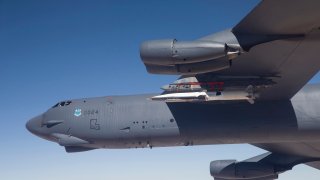
- Hypersonic air travel, for both military and commercial use, could be here within the decade.
- China, Russia and now North Korea all claim to have developed and successfully tested hypersonic missiles.
Hypersonic air travel, for both military and commercial use, could be here within the decade.
The $770 billion National Defense Authorization Act signed into law Tuesday calls for investing billions into hypersonic research and development, making them a top priority for Washington. The next step is congressional approval to allocate the money for the technology to the Pentagon.
"If you are traveling at hypersonic speeds, you're, you're going more than a mile per second," said Mark Lewis, executive director of the National Defense Industrial Association's Emerging Technologies Institute. "That's important for military applications. It could have commercial applications. It could also open up new, new ways of reaching space."
Get Boston local news, weather forecasts, lifestyle and entertainment stories to your inbox. Sign up for NBC Boston’s newsletters.
Hypersonic is anything traveling above Mach 5, or five times the speed of sound. That's roughly 3,800 mph. At those speeds, commercial planes could travel from New York to London in under two hours.
Significant hypersonic research and development in recent years have highlighted its promising opportunity, but it's also shed light on its destructive potential. According to Rand Corp., hypersonic technology creates a new class of threat that could change the nature of warfare.
"There truly is a sense of concern that we are in a race," said Lewis, who is a former director at the Department of Defense. "We took our foot off the gas. … There are other nations, peer competitors, who are investing very, very heavily in hypersonics."
Money Report
China, Russia and now North Korea all claim to have developed and successfully tested hypersonic missiles. Unlike traditional ballistic missiles that follow a set trajectory after launch, hypersonic weapons are maneuverable in flight, incredibly fast and hard to detect.
The U.S. doesn't have operational hypersonic missiles yet, but it's a top priority for Washington. According to the Government Accountability Office, funding for hypersonic research increased by 740% between 2015 and 2020. The latest defense budget alone increased funding by 20%.
"It's truly a bipartisan issue," said Lewis.
The DOD is gathering data across multiple agencies, industry leaders and academia as it races to fast-track production on its first hypersonic missile by September 2022.
"We don't want to just match them missile for missile, but introduce new capabilities of transportation capabilities, sensor capabilities. And I'm seeing that play out," Lewis told CNBC.
Watch the video to find out more about hypersonic technology, what it could do for military and commercial purposes, and why it's taking so long to get off the ground.






